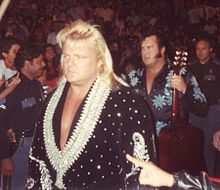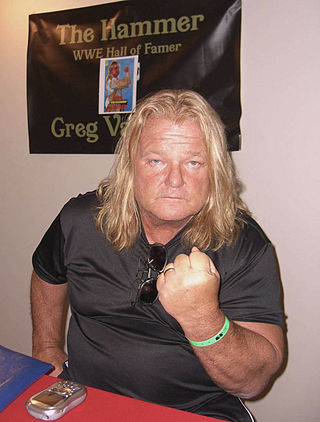
Jonathan Anthony Wisniski is a retired American professional wrestler, better known as Greg "the Hammer" Valentine. He is the son of wrestler Johnny Valentine.

Jacques Rougeau Jr. is a Canadian former professional wrestler best known for his appearances in the 1980s and 1990s with the World Wrestling Federation. He began his career under his real name as half of the tag team The Fabulous Rougeaus with his brother Raymond Rougeau. In 1991, he began a singles career as the Mountie, winning the WWF Intercontinental Heavyweight Championship once. In 1993, he formed three time WWF Tag Team Championship winning tag team The Quebecers with Pierre Ouellet.

James Ray Hart is an American professional wrestling manager, executive, composer, and musician. He is currently signed to WWE in a Legends deal. He is best known for his work in WWE when it was still known as the World Wrestling Federation and World Championship Wrestling (WCW), and used the nickname "the Mouth of the South".

Roy Wayne Farris is an American former professional wrestler. He is best known for his tenure in the World Wrestling Federation from 1986 to 1991, where he performed under the ring name The Honky Tonk Man. He also performed for World Championship Wrestling (WCW) in 1994, and for Stampede Wrestling between 1982 and 1986. He was inducted into the WWE Hall of Fame as part of the 2019 induction ceremony. A heel for the majority of his active professional wrestling career, he has been described by Bleacher Report as "one of the greatest villains to ever grace a professional wrestling ring". His 454-day reign as WWE Intercontinental Champion was the longest reign in the history of the title until it was broken by Gunther in 2023.
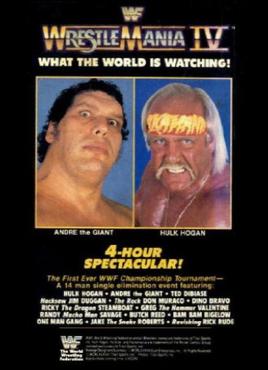
WrestleMania IV was the fourth annual WrestleMania professional wrestling pay-per-view (PPV) event produced by the World Wrestling Federation. The event took place on March 27, 1988, at Boardwalk Hall in Atlantic City, New Jersey. The announced attendance of the event was 19,199.
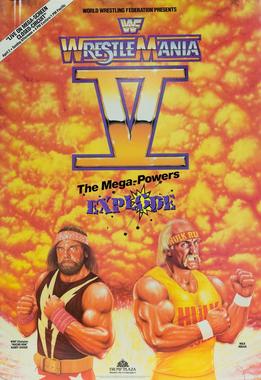
WrestleMania V was the fifth annual WrestleMania professional wrestling pay-per-view (PPV) event produced by the World Wrestling Federation. It took place on April 2, 1989, at the Boardwalk Hall in Atlantic City, New Jersey. A total of 14 matches were contested at the event.

WrestleMania VI was the sixth annual WrestleMania professional wrestling pay-per-view (PPV) event produced by the World Wrestling Federation. It took place on April 1, 1990, at the SkyDome in Toronto, Ontario, Canada, marking the first WrestleMania to be held outside of the United States. The event had an announced attendance of 67,678, a record for the Skydome at the time. The main event of WrestleMania VI was "the Ultimate Challenge" — the main event match pitting WWF Champion Hulk Hogan against WWF Intercontinental Heavyweight Champion the Ultimate Warrior.

James W. Ware Jr., better known by his ring name Koko B. Ware, is an American retired professional wrestler. He debuted in 1978 and became widely popular in 1986. He later went on to the World Wrestling Federation, where he went from strong mid-carder to jobber to the stars. "The Birdman" came to the ring with a blue-and-yellow macaw named Frankie, both flapping and dancing before and after his matches. Before joining the WWF, he was in several tag teams, most notably with Bobby Eaton in Memphis and with Norvell Austin in several promotions. In 1993, during the premiere episode, he lost the first Monday Night Raw match to Yokozuna. In 2009 he was inducted into the WWE Hall of Fame.

Brian Wickens is a New Zealand professional wrestler. He is best known for his appearances in the World Wrestling Federation under the ring name Bushwhacker Luke, where he teamed with Bushwhacker Butch as The Bushwhackers. He is also known for his appearances under the ring name Luke Williams for promotions such as NWA New Zealand, Stampede Wrestling, Pacific Northwest Wrestling, Mid Atlantic Championship Wrestling, Southwest Championship Wrestling, and the Universal Wrestling Federation, where he teamed with Butch as "The Kiwis" and "The Sheepherders".
The Natural Disasters were a professional wrestling tag team composed of Earthquake and Typhoon who worked in the World Wrestling Federation between 1991 and 1993. They won the WWF Tag Team Championship once. They had feuded with each other before becoming a team.

The Bushwhackers were a professional wrestling tag team who competed first as the New Zealand Kiwis and then as The Sheepherders during their 36-year career as a tag team. They wrestled in the World Wrestling Federation, Jim Crockett Promotions, and on the independent territorial wrestling circuits. The Bushwhackers consisted of Butch Miller and Luke Williams while the Sheepherders also included Jonathan Boyd and Rip Morgan as members at times. Williams and Miller were inducted into the WWE Hall of Fame class of 2015, and the Professional Wrestling Hall of Fame and Museum in 2020.

The Dream Team was a World Wrestling Federation tag team from 1985 to March 29, 1987 consisting of Brutus Beefcake and Greg Valentine managed by "Luscious" Johnny Valiant. The New Dream Team, also managed by Johnny Valiant, saw Dino Bravo replace Brutus Beefcake and competed from March 1987 until the winter of 1988.

The 1988 SummerSlam was the inaugural SummerSlam professional wrestling pay-per-view (PPV) event produced by the World Wrestling Federation. It took place on August 29, 1988, at Madison Square Garden in New York City, New York. The pay-per-view was created to help the company compete against rival promotion Jim Crockett Promotions. It was one of the first four annual pay-per-view events produced by the WWF, along with WrestleMania, the Royal Rumble, and Survivor Series, which were eventually dubbed the "big four".
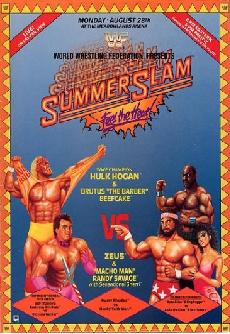
The 1989 SummerSlam was the second annual SummerSlam professional wrestling pay-per-view (PPV) event produced by the World Wrestling Federation. It took place on August 28, 1989, in the Meadowlands Arena in East Rutherford, New Jersey. Ten matches were contested at the event, including one dark match held before the live broadcast.

The 1990 Royal Rumble was the third annual Royal Rumble professional wrestling pay-per-view (PPV) event produced by the World Wrestling Federation. It took place on January 21, 1990, at the Orlando Arena in Orlando, Florida. It centered on the Royal Rumble match, a modified battle royal in which participants enter at timed intervals instead of all beginning in the ring at the same time.

The 1989 Royal Rumble was the second annual Royal Rumble professional wrestling event produced by the World Wrestling Federation. After the inaugural event aired as a television special, the 1989 event aired on pay-per-view (PPV), thus becoming one of the WWF's original four annual PPV events, along with WrestleMania, SummerSlam, and Survivor Series, which would become recognized as the "Big Four". It took place on January 15, 1989, at The Summit in Houston, Texas. It centered on the Royal Rumble match, a modified battle royal in which participants enter at timed intervals instead of all beginning in the ring at the same time.

The 1987 Survivor Series was the inaugural Survivor Series professional wrestling pay-per-view (PPV) event produced by the World Wrestling Federation. It took place on Thanksgiving Night on November 26, 1987, and was held at the Richfield Coliseum in Richfield Township, Ohio. It was one of the first four annual pay-per-view events produced by the WWF, along with WrestleMania, introduced in 1985, and Royal Rumble and SummerSlam, introduced in 1988, referred to as the "Big Four".
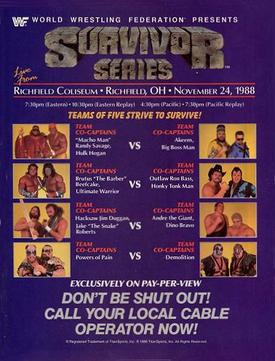
The 1988 Survivor Series was the second annual Survivor Series professional wrestling pay-per-view (PPV) event produced by the World Wrestling Federation. It took place on November 24, 1988, at the Richfield Coliseum in Richfield Township, Ohio for the second consecutive year. Four matches were contested at the event.
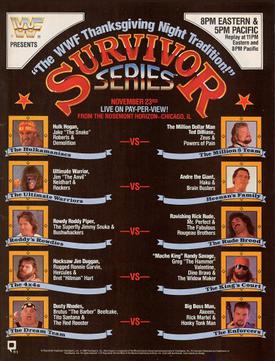
The 1989 Survivor Series was the third annual Survivor Series professional wrestling pay-per-view (PPV) event produced by the World Wrestling Federation. It took place on Thanksgiving Day on November 23, 1989, at the Rosemont Horizon in the Chicago suburb of Rosemont, Illinois.
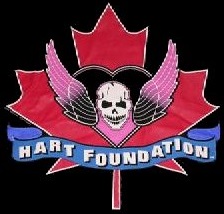
The Hart Foundation is the name of several derivative tag teams and stables composed primarily of members and close friends of the Hart wrestling family. The name originated in the World Wrestling Federation in 1985 with the original Hart Foundation consisting of brothers-in-law Bret Hart and Jim Neidhart. Initially managed by Jimmy Hart, they won the WWF Tag Team Championship twice. WWE has consistently ranked the original Hart Foundation as one of the greatest tag teams in wrestling history.
